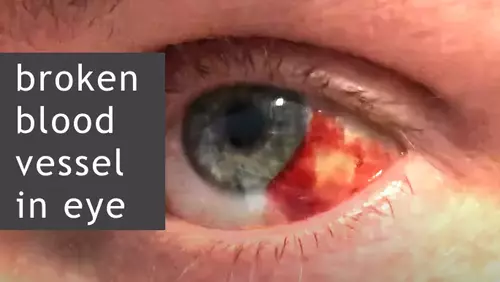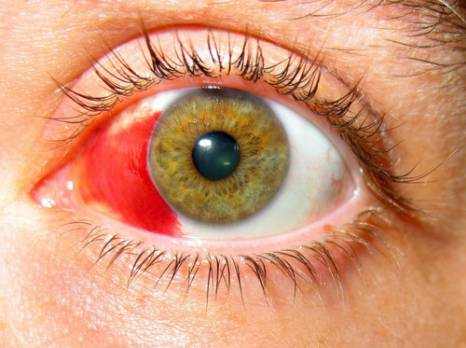Therefore, those who are faced with this problem (namely, the rupture of blood vessels after eye surgery) should immediately contact your doctor to avoid complications.
Broken Blood Vessels in Eyes
If you find a broken blood vessel in your eye, you don’t have to worry right away. In most cases, subconjunctival hemorrhage (the medical name for this condition in the eye) will go away on its own in 5-20 days.

Causes of a Broken Blood Vessels in Eyes
Besides the noticeable bleeding in between the sclera (the white part of the eye) and conjunctiva, many people describe a scratchy or itchy feeling on the surface of the eye. Pain is normally non-existent or very little, and there is no change in vision, although there might be some pain.
The conjunctiva consists of numerous nerves and tiny blood vessels. These blood vessels (which are hardly visible until they become inflamed and enlarged) are delicate, and their walls can easily break. Occasions that can cause capillary on the front of the eye to break include:
- Sneezing
- Coughing
- Vomiting
- Straining
- Improperly managed high blood pressure
- Weeping
- Rubbing your eyes
- Blunt trauma
- Increased intracranial or intraocular pressure
- Shaken baby syndrome (often the case in children with subconjunctival hemorrhages in both eyes).
This is not an exhaustive list; frequently the precise reason for the injury is unknown. There are a number of factors that can increase the risk of a broken blood vessel on the front of the eye. For instance, medications and supplements such as warfarin, aspirin, Plavix, and high doses of vitamin E can thin the blood and make it much easier for hemorrhages to take place.
Although rare, St. John’s wort, ginkgo biloba, ginger, and cayenne can also increase one’s risk if taken in high dosages. Periodically, blood vessels on the front of the eye will break due to conjunctivitis (eye infection) and high blood pressure.
One More Reason: Post-Surgery Condition
Most vision-correcting operations, including LASIK or cataract surgery, require a special approach to postoperative recovery from the patient. In particular, the patient should avoid a rush of blood to the head (and, accordingly, to the eyes).
Moreover, if this rule is broken, the rupture of the blood vessels of the eye is quite real.
Therefore, those who are faced with this problem (namely, the rupture of blood vessels after eye surgery) should immediately contact your doctor to avoid complications.

Risks of a Broken Blood Vessel in Your Eye
If you have observed the look of blood in your eye, it might be advisable for you to look for medical attention. While a broken blood vessel in your eye is seldom unsafe, hyphema (blood in the front chamber of the eye, between the cornea and the iris) is possibly a more serious condition, with more major effects.
Diagnosing a Broken Blood Vessel in Your Eye
If you have a damaged blood vessel in your eye, you ought to call your eye doctor and schedule a consultation. For the most parts, a simple eye test suffices for an optometrist to properly detect a subconjunctival hemorrhage.
If the cause is unidentified, however, your doctor might carry out a series of tests to rule out other eye conditions that may be causing the hemorrhaging. Your optometrist will ask you about your case history (medications consisted of), and about any activities that may have induced the rupture.
If trauma is the cause, a more comprehensive evaluation will be carried out to make sure that damage has actually not occurred to other structures in your eye.
Treatment of a Broken Blood Vessel in Eye
Most of the times, treatment is not needed for a subconjunctival hemorrhage. If you are experiencing discomfort or pain, over-the-counter pain medications such as Tylenol might be recommended.
A Broken Blood Vessel in Your Eye — What You Can Do

Written by
Dr. Mounir Bashour

Medically reviewed by
Michael Garin O.D.
- Symptoms and Causes of a Broken Blood Vessel on the Front of the Eye ↓
- Risks of a Broken Blood Vessel in Your Eye ↓
- Diagnosing a Broken Blood Vessel in Your Eye ↓
- Treatment of a Broken Blood Vessel in Your Eye ↓
- Preventing Broken Blood Vessels in Your Eye ↓
- Questions to Ask Your Doctor ↓
Also known as a subconjunctival hemorrhage, a broken blood vessel in your eye is typically a harmless condition (although see below ) that clears up within one to three weeks.
Subconjunctival is the term used to describe the space located just beneath the conjunctiva (the clear surface of your eye). The term hemorrhage refers to the breakage of tiny blood vessels.
Most people do not realize they have a broken blood vessel in their eye until someone tells them or they look in a mirror. This condition is not painful, and typically develops after blunt trauma to the eye. In most cases, treatment is not needed for a subconjunctival hemorrhage.

Symptoms and Causes of a Broken Blood Vessel on the Front of the Eye
Besides the visible bleeding between the sclera (the white part of the eye) and conjunctiva, many people describe a scratchy or itchy feeling on the surface of the eye. Pain is generally non-existent or minimal, and there is no change in vision, although there may be some discomfort.
The conjunctiva contains several nerves and tiny blood vessels. These blood vessels (which are barely visible until they become inflamed and enlarged) are fragile, and their walls can easily break. Events that can cause blood vessels on the front of the eye to break include:
- Sneezing
- Coughing
- Vomiting
- Straining
- Poorly controlled blood pressure
- Crying
- Rubbing your eyes
- Blunt trauma
- Increased intracranial or intraocular pressure
- Shaken baby syndrome (often the case in children with subconjunctival hemorrhages in both eyes)
This is not an exhaustive list; often the exact cause of the injury is unknown. There are several factors that can increase the risk of a broken blood vessel on the front of the eye. For example, medications and supplements such as warfarin, aspirin, Plavix, and high doses of vitamin E can thin the blood and make it easier for hemorrhages to occur.
Although rare, St. John’s wort, ginkgo biloba, ginger, and cayenne can also increase one’s risk if taken in high doses. Occasionally, blood vessels on the front of the eye will break due to conjunctivitis (eye infection) and high blood pressure.
Risks of a Broken Blood Vessel in Your Eye
If you have noticed the appearance of blood in your eye, it may be advisable for you to seek medical attention. While a broken blood vessel in your eye is seldom dangerous, hyphema (blood in the front chamber of the eye, between the cornea and the iris) is potentially a more serious condition, with more serious consequences.
Diagnosing a Broken Blood Vessel in Your Eye
If you have a broken blood vessel in your eye, you should contact your eye doctor and schedule an appointment. In most cases, a simple eye exam is enough for an eye doctor to properly diagnose a subconjunctival hemorrhage.
If the cause is unknown, however, your doctor may perform a series of tests to rule out other eye conditions that may be causing the hemorrhaging. Your eye doctor will ask you about your medical history (medications included), and about any activities that may have induced the rupture.
If trauma is the cause, a more thorough examination will be performed to ensure that damage has not occurred to other structures in your eye.
Treatment of a Broken Blood Vessel in Your Eye
In most cases, treatment is not needed for a subconjunctival hemorrhage. If you are experiencing pain or discomfort, over-the-counter pain medications such as Tylenol may be recommended.
Aspirin and related products should be avoided due to their blood-thinning side effects. Those who take aspirin or anticoagulants for a medical condition should talk with their eye doctor to determine whether it is safe to continue using these during the healing process.
Over-the-counter artificial tears may also help reduce any irritation. If the subconjunctival hemorrhage is due to trauma, other treatment may be necessary to promote healing. If an infection is present, antibiotic eye drops or ointment may be prescribed.
Typically, the condition clears up on its own within two or three weeks, without long-term problems.
Preventing Broken Blood Vessels in Your Eye
Broken blood vessels in your eye can sometimes be prevented. To avoid eye injuries, wear protective eyewear during athletic events or whenever you are exposed to environments that involve flying particles (such as dust) or bright sunlight.
If you are experiencing recurrent broken blood vessels in your eye, seek medical attention to rule out underlying blood-clotting conditions. Treatment of an underlying medical condition can prevent symptoms such as broken blood vessels.
Questions to Ask Your Doctor
- How severe is my hemorrhage?
- How long will my eye be red?
- What can I do to prevent this from happening again?
- Which treatment options do I have?
- Which complications may arise if my eye is left untreated?
- Could this harm my vision in the future?
- J. Anshel, MD “Smart Medicine for Your Eyes” (SquareOne Publishers, 2011) 138-139, 134-135
- J. DiGirolamo, MD “The Big Book of Family Eye Care” (Basic Health Publications, 2011) 174-176
- J. Lavine, MD “The Eye Care Sourcebook” (Contemporary Books, 2001) 105-106






